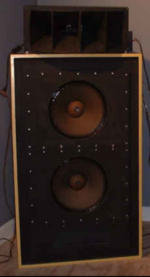Greets!I was planning to fix the drivers to the front baffle using bolts with nylocks on, and then screw the baffle to the speaker cabinet. What is your opinion?
Also, where there are removable panels, even though they screw into the main cabinet, you still see internal battens. What is the purpose of these, is it to strengthen the cabinet, or to increase the surface area / create a seal to the front baffle.
I much prefer to make a solid cab and have removable baffles, especially when the drivers are quite heavy as mine are.
Here's one of a pair that were originally firing into the corners as wide range subwoofers, but if I needed to make them presentable I would make a Velcro attached flush fit framed cloth grill insert.
As for battens, mine are for making the cab extremely rigid, driver board framing and due to driver weight are 2x6 lumber top, bottom and 2x4 on the sides, crossbar, ditto back with basic box 3/4" no void marine grade plywood.
Attachments
Since you’re going to spend a lot on speaker, invest in Bessey clamps. They’ll last a life long and even do well on the second-hand market.I'm not sure about those clamps you link to.
I'd suggest mounting the drivers with wood screws as Troels does - just follow his explanation of how he strengthens the holes. If you do that then you could simply bond your front baffle to inner battens of 25mm x 25mm strips of hardwood around the inner perimeter of your cabinets using construction adhesive. (I'll assume it's available in tubes from a building center like in N. America. It's a thick, pasty, urethane glue). You can clamp the baffle while the glue sets. Its advantage over a traditional PVA wood glue in this case is that it will seal any small gaps around the baffle. Use masking tape to protect finished surfaces though the adhesive will clean up with solvent while soft.
Osmo would be a good choice as a finish.
Osmo would be a good choice as a finish.
I think your right. I plan on using 24mm ply for the cabinet, so wood screws should be okay for the drivers. I could always glue small square blocks at the screw locations to increase the bite...
I'm now debating on the exact construction method.... I like speakers where cabinet forms a picture frame around the baffle. If I did this I would just put clear coat on the birch ply. But I also want to get away from what would still look like a massive ply box, so I'm leaning towards using an oak veneer, but I think this would be easier with the picture frame baffle arrangement.
I'm now debating on the exact construction method.... I like speakers where cabinet forms a picture frame around the baffle. If I did this I would just put clear coat on the birch ply. But I also want to get away from what would still look like a massive ply box, so I'm leaning towards using an oak veneer, but I think this would be easier with the picture frame baffle arrangement.
I'm not understanding your statement, perhaps thrown off by your last sentence. When you say lovely sides are you referring to the veneered face, or the multi-layered edge? I'm certainly familiar with using a bearing bit to trim but if you're referring to trimming edging it would have to be with the router on a front baffle that is absolutely flush with the edging. (Unless, of course we're referring to completely different actions?) If, in your last sentence, you're referring to the 45° corners where the edging strips meet at a corner, fussy yes, overly difficult no. A good miter saw and guide will do it. Lee Valley has a small set of inexpensive miter guides which are meant to be used on a wooden 'frame' of your making which, when used with their fine toothed miter saw, does an excellent job. Not being snarky, just confused.
I referred to the multi-layered edges. But that’s not an option in three dimensions, so you have to do the 45° corners somewhere. Not having trouble with 45° edges, my table saw cuts them for breakfast. And a good bit in a table router does the job easily too. But not anyone has access to such tools.
Ah, that explains it. Thanks.
Personally, I'd rather not cut a 45° on 3/4" (19mm) anything on a router table. My router tables aren't deep enough to handle a large panel and that would also require a large bit at a slow speed.
Personally, I'd rather not cut a 45° on 3/4" (19mm) anything on a router table. My router tables aren't deep enough to handle a large panel and that would also require a large bit at a slow speed.
- Home
- Loudspeakers
- Multi-Way
- Help - Practical Speaker Building Tips / Advice required
